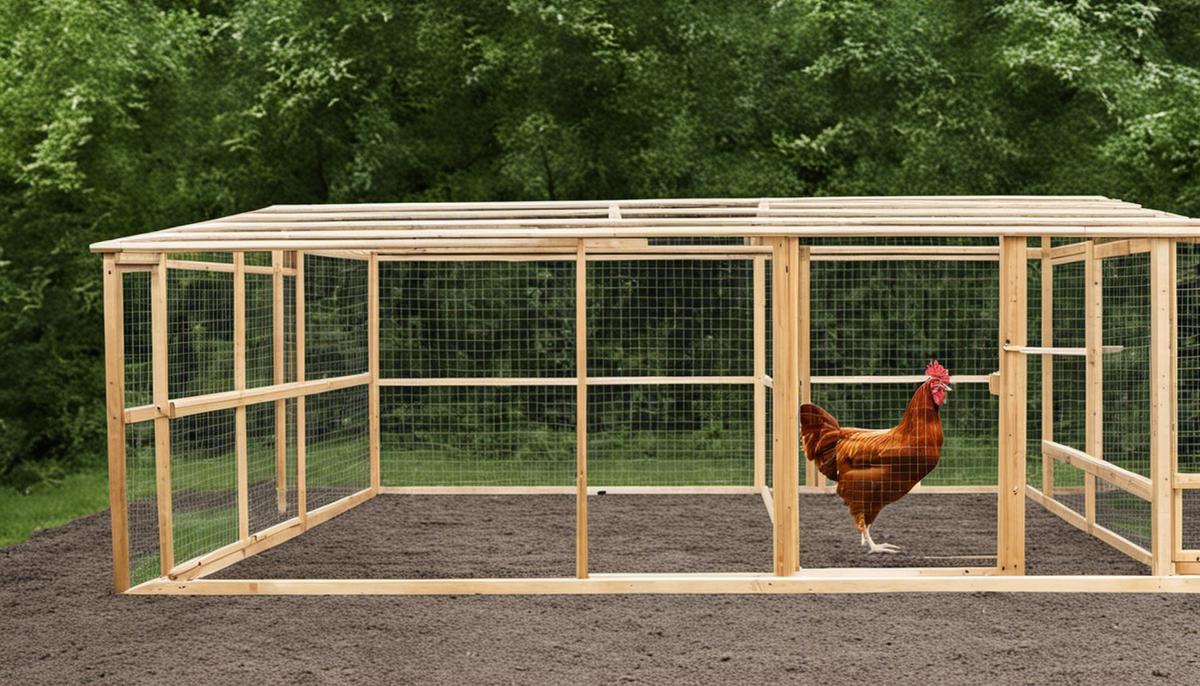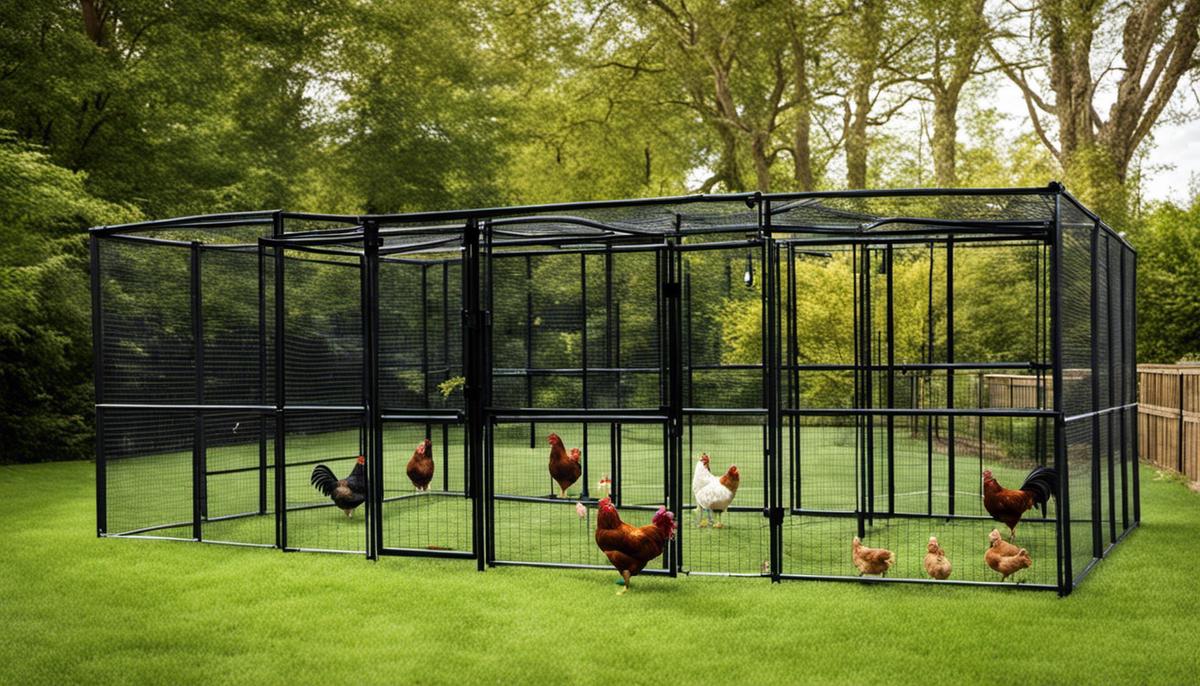Raising backyard chickens is an increasingly popular hobby that offers plentiful benefits, from fresh, organic eggs to the sheer joy of watching your feathered flock. Central to keeping happy and healthy chickens is providing them with a safe, comfortable, and functional living space – namely, a chicken run. However, the process of building a chicken run that meets your specific needs and those of your chickens requires a proper understanding of crucial aspects, including effective design, appropriate material selection, meticulous construction, and rigorous safety measures. If you’re thinking about building your own chicken run, listed below is a step-by-step guide of every detail you must take into consideration.
We will receive a commission if you purchase through our affiliate link at no extra cost to you. Please read our disclosure policy for more information.
Designing the Chicken Run
Understanding the Basics
Designing a chicken run requires a good understanding of your specific needs. This starts with determining the size of the chicken run, which relies heavily on the number of chickens you plan to house. Keep in mind that chickens grow quickly. A space that seems sufficient for small chicks can quickly become crowded as they grow. As a general guideline, plan for at least ten square feet per chicken to ensure they have plenty of room to roam.
Considering Threats
Safety is a crucial aspect when designing a chicken run. You need to be aware of the predators in your area. Foxes, raccoons, hawks, and even domestic pets can pose a threat to your flock. You will need to consider the safety measures like robust fencing, a secure door latch, or even a roof in the designs, depending upon the types of predators.
Sketching it Out
The next step is to sketch out your design. Your design should include a coop for the chickens to sleep and lay eggs, and an outdoor run area for them to explore and exercise. The coop should be elevated from the ground to keep pests and rodents out, with a ramp for the chickens to enter and exit.
Designing Access Points
Another vital factor to consider while designing the chicken run is the access points for feed and water. The positioning of these can make a real difference in the overall maintenance of your chicken run. The feeders and waterers should be easily accessible for refilling. They should be positioned in a way that the chickens cannot roost on them or accidentally knock them over.
Anticipating Cleaning and Collecting Needs
On top of everything, your design should also accommodate for routine cleaning and egg collection. A removable tray or an accessible spot in the coop can make a big difference when it comes to cleaning the coop regularly. An external egg collection door can save you the hassle of entering the coop every day to collect the eggs.
Rolling with Changes
Remember, making changes to your design as you build is okay. As you start working, you may find some aspects of your design aren’t functioning as well as you thought they might. That’s all part of the process. The most important thing is to create a safe and comfortable space for your chickens.

Selecting Materials
Choosing Lumber for Your Chicken Run
First, in crafting your chicken run, you’ll want to select the right type of lumber. The most suitable wood is untreated, as treated wood can contain chemicals hazardous to chickens. Choose sturdy wood types such as cedar, redwood, or pine, known for their durability and resistance to rot.
Sorting Through Mesh and Chicken Wire Options
Next up is selecting the mesh or chicken wire. The purpose here is to keep your chickens safe from predators while also providing them plenty of air and light. For this, a galvanized hardware cloth or chicken wire with small openings of around half an inch is ideal. Remember, the smaller the grid, the less likely predators can reach through.
Picking the Right Hardware
When it comes to hardware, you’ll need nails or screws, hinges for the coop door, and potentially latches. Stainless steel or galvanized options are best, as they’ll withstand the elements and last longer than regular iron nails or screws. A sturdy latch is crucial to keep any crafty predators from getting into your chicken run.
Selecting Chicken Run Roofing Materials
Roofing for your chicken run is also key; it protects your chickens from predators and harsh weather conditions. You can use corrugated plastic, wood, metal, or even a tarp. However, ensure that whatever material you choose, it should be durable enough to withstand wind and heavy rain or snow. It’s an added bonus if you manage a material—like clear corrugated plastic—that lets light in as well.
Weather-Proofing Your Chicken Coop
Finally, consider a weatherproof stain or paint for the chicken coop portion of the run. This isn’t just for aesthetics; a good-quality, non-toxic, weatherproof stain or paint can add years onto the lifespan of your coop by protecting the wood from rot and weather damage. Make certain it’s approved for uses around livestock and poultry. A light shade can keep the coop cooler in the summer by reflecting sunlight.

Building the Chicken Run
Design and Preparations
First, decide on the size and shape of your chicken run. Choose a flat area of ground that’s free of rocks and trees, ensuring it’s spacious enough to suit your flock’s needs. The minimum rule of thumb is about 10 square feet per bird. Once the location is determined, use marking paint or strings to outline the area. Gather all necessary tools and materials, including chicken wire or mesh, wood for the frame, screws or nails, a staple gun, doors, and hardware, along with roosting bars and nesting boxes.
Constructing the Frame
The frame of your chicken run provides structural support and determines the overall shape and size of your run. You’ll need four posts for the corners and additional posts for sides if the run is large. Dig holes for the posts, place them in, and backfill with soil. Ensure the posts are stable and level to the ground. Connect the posts using 2x4s to create the frame, prioritizing sturdiness.
Adding Mesh or Wire
Use chicken wire or a more durable hardware cloth to cover your chicken run. This will serve as a barrier to prevent predators from entering the area. Begin at one corner and unroll the material along the structure, cutting as needed. For the best protection, bury about 12 inches of wire underground or curve it outward to prevent digging animals from getting under. Use a staple gun or screws to secure the mesh to the frame.
Creating Accessible Doors
It’s important to create doors for easy access to the chicken run — a larger one for people and a smaller one for chickens. The human door should be at least 3 feet wide and 6 feet tall, so it’s comfortable to walk through. Build the frame for the door in the same way as the previous frame, then cover with mesh. For the chicken door, create a square about 12×12 inches. Consider adding hinges and latches for both doors for easy access and added security.
Adding Roosting Bars and Nesting Boxes
Inside the run, put up roosting bars where your chickens can perch and sleep. These can be simple 2x2s or 2x4s, preferably rounded or sanded to prevent splintering. Space the bars about 10-12 inches apart so chickens can fly up and down without interference. Also, include nesting boxes for egg-laying. You can use crates, old drawers or even cardboard boxes filled with straw or wood shavings.
Consider a Roof
A roof can offer protection against predators and weather. You may opt for a solid wooden roof, corrugated metal or plastic, or even a wire mesh if your area is predator-free. Attach your chosen roofing material to the top of the frame using screws, nails, or a staple gun. Remember, if using a solid material, to angle the roof for rain runoff.
By following these steps, you ensure not just a safe and secure area but a lively and comfortable environment where your chickens can flourish.

Safety Measures
Safety measures for chicken runs are crucial to ensure the health and protection of your chickens.
One vital aspect is thorough, regular inspections. Over time and due to various weather conditions, your chicken run may develop holes, cracks, or other types of damage.
These faulty points may provide opportunities for predators to enter your chicken run, threatening the safety of your chickens.
In addition to visual inspections, pay attention to any signs of digging around your chicken run perimeter.
Various predators such as foxes, raccoons, or weasels, have digging habits and can burrow under fences or walls to gain access to your poultry.
Equally important is the necessity for robust locks on every access point of the chicken run.
Regardless of whether that’s a simple hatch or a full-size human door, each should be lockable to keep out predators.
Remember that some predators are quite dexterous and can open simple latches.
Therefore, using lock types such as padlocks, combination locks or bolt locks is advisable.
These locks deter not only animal predators but potential poultry thieves as well.
Cleanliness is a non-negotiable aspect of chicken run safety.
A dirty run can quickly become a breeding ground for diseases and pests.
Regularly remove chicken droppings, uneaten food, and other waste.
A deep clean, including all surfaces and corners, should be done periodically.
Ensuring your chickens have fresh water and clean feeders also helps prevent illness.
It’s beneficial to educate yourself about common chicken predators.
Understanding their behavior and habits will enable you to anticipate potential problems and to design your chicken run to offer maximum security.
Foxes, for example, are nocturnal and are known to dig under fences.
Hawks and other birds of prey can attack from above.
Cats, dogs, and raccoons can climb fences, while minks and rats can squeeze through very small spaces.
With knowledge about these predators, you can fortify your chicken run accordingly, perhaps including an overhead net to prevent attacks from the sky, burying a portion of your fence underground to prevent digging, and ensuring your fences are high and stable enough to deter climbing.
Overall, vigilance and proactive measures ensure your chicken run remains a secure safe haven for your chickens.
Be aware and act fast on any signs of predator intrusion or disease, and your chickens should live long, healthy lives.

Ultimately, creating an ideal environment for your chickens to roam, forage, perch, and relax remains paramount. Understanding the principles of design, choice of materials, construction techniques, and safety measures guides you in building a custom chicken run that will ensure your flock’s longevity, productivity, and happiness. A well-planned and well-executed chicken run is more than just a poultry enclosure; it becomes a healthy and joyful home for your chickens. Armored with this knowledge, you’re now ready to take the first steps towards providing the optimal environment for your feathered friends.




